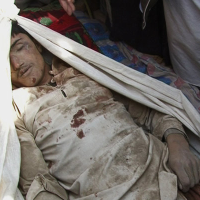Afghan Government and Taliban Unite…to Spread Fake Information about U.S. Air Strike
 4-year-old photo released by Afghan government (photo: Afghanistan Presidential Palace)
4-year-old photo released by Afghan government (photo: Afghanistan Presidential Palace)
The Taliban and the government of Afghanistan—which have been at war with each other for more than a decade—put their differences aside recently to jointly blame the United States for a military strike that killed multiple civilians. The accusations included misleading—as well as outright false—information against American forces, raising the question of why the Obama administration insists on brokering a long-term security agreement with President Hamid Karzai, whose office helped spread the lies.
The incident in question occurred on January 15 near the remote village of Wazghar. Initial reports said two civilians and many more insurgents died during the fighting, which was planned and led by the Afghan Army.
But when dozens of Afghan commandoes and their American advisers got pinned down by Taliban fighters, the U.S. called in an airstrike that destroyed two compounds in the village.
Among the dead were two children.
The attack prompted an investigation by the Afghan government, said to have been conducted by a special commission appointed by Karzai, that offered a different account—complete with phony information—from the one offered by the U.S. military.
Their report said the attack was led by the U.S. and featured “eight hours of indiscriminate and unprovoked bombing followed by a house-to-house rampage by American soldiers,” according to The New York Times.
The Afghan report also said at least 12 civilians died in the fighting, and possibly three to five more.
But perhaps the most alarming part of the Afghan government’s story was the photos it showed that purportedly proved the collateral damage inflicted by the U.S.
American officials and the Times countered that the images were taken four years earlier, after a NATO-led attack killed 70 Afghan civilians in a different part of the country.
“In an apparent effort to demonize their American backers, a coterie of Afghan officials appears to have crossed a line that deeply troubles Western officials here: They falsely represented at least some of the evidence in the dossier, and distributed other material whose provenance, at best, could not be determined,” the Times’ Matthew Rosenberg wrote.
Rosenberg also reported that “much of the same material was posted on a Taliban website last week, a rare instance of the militant group’s political speech matching that of the government it is fighting to topple.”
In fact, no members of the Karzai-appointed commission went to Wazghar to conduct an investigation; it was, instead, the commission chairman’s personal driver and bodyguard who visited the site. “There wasn’t an investigation,” one commission member who requested anonymity told the Times. Commission members reportedly refused to participate due to the threat posed by Taliban insurgents.
Karzai’s government produced the doctored report for two reasons: to justify Karzai’s stalling on signing the 10-year security pact sought by the Obama White House, and to demonstrate his willingness to stand up to the Americans, hoping that it will improve his chances in peace negotiations with the Taliban.
An unidentified European diplomat told the Times that the lies told by Karzai’s officials don’t bode well for the U.S. remaining in Afghanistan beyond this year.
“There is no overall partnership,” the diplomat said. “We have some Afghan partners, and we have a lot of Afghans in the government who want us to leave. I think we’re all beginning to realize that.”
-Noel Brinkerhoff
To Learn More:
False Claims in Afghan Accusations on U.S. Raid Add to Doubts on Karzai (by Matthew Rosenberg, New York Times)
Afghan Villagers Brought to Back Airstrike Report ((by Matthew Rosenberg, New York Times)
NATO Strike Kills 2 Civilians, 10 Insurgents in Afghanistan (by Heath Druzin, Stars and Stripes)
- Top Stories
- Unusual News
- Where is the Money Going?
- Controversies
- U.S. and the World
- Appointments and Resignations
- Latest News
- Trump to Stop Deportations If…
- Trump Denounces World Series
- What If China Invaded the United States?
- Donald Trump Has a Mental Health Problem and It Has a Name
- Trump Goes on Renaming Frenzy






Comments